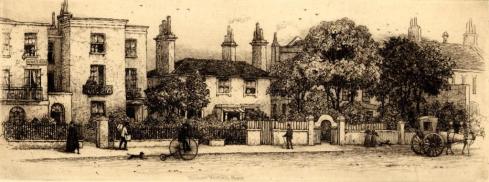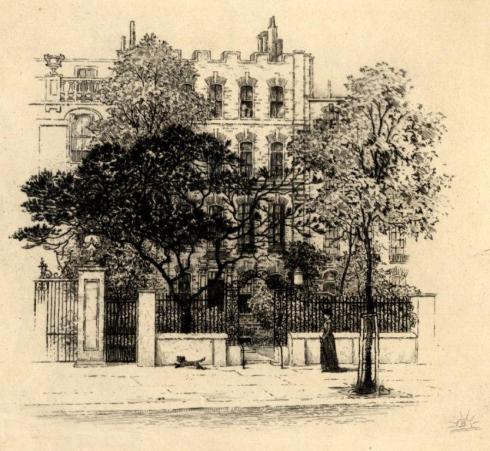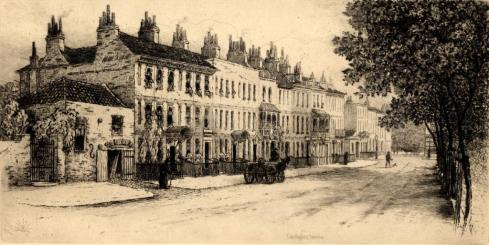It’s been some time since I last featured Walter W Burgess on the blog. I was recently searching for a picture of Madame Venturi’s house and found one of Burgess’s liveliest street scenes, full of characteristic detail, showing the King’s Road as a quiet suburban road.
The delivery man with his baskets, the ladies walking a dog straining against the leash, the eccentric tricycle, pursued by another dog (Burgess included many animals in his pictures and often had this little dog somewhere, in this case almost in duplicate.) Madame Venturi’s neat villa with a smoking chimney is right in the middle. (For more on Madame Venturi see last week’s post)
Burgess’s best work has precision (a key skill for an engraver) and a quirky character which saves it from the prettiness of which it might be otherwise be accused. Compare it with the water colourist (and engraver) W.Hosmer Shepherd who covered similar ground.
Burgess had a bit of a penchant for the houses of local celebrities and featured many in his book of etchings Bits of Old Chelsea (1894), so we can have a Hollywood style tour of Chelsea picking them out. No film stars, but famous names nonetheless.
This house, number 4 Cheyne Walk was the home of the novelist George Eliot. She moved in there with her husband John Walter Cross. You might argue that Burgess was pushing his luck in this case. George Eliot (alias Marian Evans and Mary Ann Cross) only lived there for three weeks in December 1880. Her husband, who suffered from depression had thrown himself into a Venetian canal on their honeymoon but survived. Although both of them loved the house with its views of the river, Eliot became ill with a recurrence of a kidney condition she had suffered from for years and died before the year was out. I don’t think that Burgess is suggesting that the woman following another dog in the picture is the author herself.
Cheyne Walk provided many subjects for Burgess. At number 59 was the house of W Holman Hunt.
This was a slightly more modest residence further down Cheyne Walk, close to the Old Church. When Hunt became more famous he moved to Melbury Road in Kensington – from the early Chelsea haunts of the Pre-Raphaelite Brotherhood to the more affluent neighbourhood of Lord Leighton.
(Apologies for the wavy picture on the scan. The original is a pencil drawing in a thick mount)
By contrast that other famous member of the Brotherhood, Dante Gabriel Rossetti moved to a big house at the other end of Cheyne Walk.
Number 16, also known as Queen House and Tudor House was the house Rossetti moved into in 1862 after the death of Elizabeth Siddall. Rossetti’s brother lived there for a while as did the poet Algernon Swinburne. I’ve mentioned Rossetti’s menagerie before, which included armadillos and wallabies but Burgess’s collaborator Richard Le Gallienne (who wrote the text of Bits of Old Chelsea) reports an incident I’d never heard before attributed to James McNeill Whistler. Apparently Rossetti acquired a zebu (an African species of cow) which had to be conveyed into the garden through the house tied up. It was tethered to a tree, a condition it disliked (or perhaps it never forgot its undignified entry into the property), and one day it managed to uproot the tree and charge at Rossetti who had to climb the garden wall to escape its vengeance. Rossetti never found a buyer and had to give it away although we don’t know to whom.
Once again I cannot say if Burgess intends the muffled up figure standing by the gate to be any of the residents. Intentionally or not Burgess has created a slightly disturbing character.
Whistler himself had several addresses in Chelsea. This is one of the Cheyne Walk ones:
That could almost be the same figure outside, looking a little like some of the pictures of Whistler.
This is another pencil drawing of number 6 Cheyne Walk, the house of Dr Dominceti.
Bartholomew Dominceti bought the house in 1766 and provided therapy with medicated steam baths. There were 30 sweating chambers in the garden and four fumigating bedchambers. Although he attracted many famous names to the house, Dr Johnson decried his work. He left the house encumbered with debt but was remembered by many.
Mr Burgess’s tour takes us away from the river now to Upper Cheyne Row, at the end of which stood the house that Dr Phene built. The the picture below, “the house where the coal man has just made his delivery” was the residence of the frequently impecunious journalist and poet Leigh Hunt.
Hunt was supposedly the model for Harold Skimpole in Dickens’s novel Bleak House. Although Hunt was recognisable to all his friends he seems to have remained on friendly terms with Dickens. He was also on good terms with a man who lived round the corner in Cheyne Row , someone who was definitely the greatest Chelsea celebrity of his day.
Thomas Carlyle,historian, critic and “The Sage of Chelsea” lived in the house which is now a museum dedicated to him from 1834 (Hunt was at the door to welcome him and his wife Jane as they arrived by hansom cab) In his old age he took frequent solitary walks and has been depicted by other Chelsea artists such as Walter Greaves. This might be him in the view below:
In deference to the great man, let’s have one more view of the house.
I think that plaque is a depiction of Carlyle so presumably this is a later view, after his death and the creation of the museum .
I’ve used this picture before but Belle Vue House, on the right was the home not only of the poet and painter William Scott Bell, an early member of the Pre-Raphaelite Brotherhood but also the birthplace of the novelist Elizabeth Gaskell.
Bell bought the house later in his life. Unlike the other members of the Brotherhood, Bell was not championed by John Ruskin but he retained the friendship of Rossetti.
Burgess also takes us to JMW Turner’s house with this small sketch. Turner lived there incognito with his housekeeper Mrs Booth and died there in 1851. Compare the picture with a similar view by W Hosmer Shepherd in this post.
The house of Thomas More was also long gone by the time Burgess was working but there may have been remants of it, such as this mulberry tree in the grounds of a Catholic seminary in Beaufort Street. A picturesque view in any case.
Heading west again the tour takes us out of Chelsea for a final celebrity resident.
Sandford Manor, in Fulham, is often said to have been the home of Nell Gwynne, the mistress of Charles II, and a key figure in Chelsea history and/or mythology, so I couldn’t leave her out. However very few of the many biographies of her mention this. One says that a great many houses have been associated with her, too many to be entirely credible.
But let’s think of “pretty witty Nell” as she was sometimes known walking in her garden. One of these days she can have a post all to herself.

















August 27th, 2015 at 1:13 am
I was born at 108 Cheyne Walk and apparently christened at Chelsea old church which had been largely destroyed by a bomb during the war. I may have the details wrong but remember being told that near George Eliot’s house was what I think was a coffee house known as Don Saltiero’s house but don’t know if this was a real place or a childhood misremember. My mother also told me that Percy Cudlip who I think was the editor of the Sun moved in next to us – all very vague but would love to know more.
August 27th, 2015 at 11:40 am
Sarah, all I know is that 108 Cheyne was home to British sculptor John Tweed from 1895 from his death in 1933. His closest friend Rodin often visited him there.
https://www.rbkc.gov.uk/subsites/visitkensingtonandchelsea/seedo/people/blueplaques/recordss-u/johntweed.aspx
By the way, I was brought up round the corner from you in Riley Street on the Cremorne Estate.
Chris
August 27th, 2015 at 12:16 pm
Sarah
Don Saltero’s Coffee House was at 18 Cheyne Walk (his first was near Lawrence Street but the later one was the famous version) and was started in 1718 by John Salter who had been a servant of Sir Hans Sloane. It was popular with the literary establishment of the day and also famous for its collection of curious objects (see the post Shepherd in Chelsea for more details). By 1862 the building had been turned into a private residence.
Dave
August 27th, 2015 at 5:39 pm
Excellent post, thanks for that Dave. Some of these I haven’t seen before. As you say,not much is known about Walter, so I did a little research myself using online resources.
Walter William Burgess was born in Southampton in late 1844 or early 1845, the son of a coach builder, William Burgess, who died in 1856. By 1861, Walter has moved to London and is listed as a “page” in a Bloomsbury household, whilst his widowed mother Sarah, his two sisters and brother are still in Southampton.
In 1871 Walter, his mother and sister Sarah Jane are all together in London, living at 14 Markham Street, Chelsea. By 1881 they have been joined by Walter’s other sister Anna Maria and are living at 7 Paultons Street, Chelsea, where Walter remains with his family until his death in 1908.
He gives his occupation variously as: draughtsman; draughtsman for stained glass; artist and painter, etcher; painter, etcher and engraver.
In 1907, a year before his death, he married a certain Hannah Marie MacKay of Fulham, who is listed as still living at 7 Paultons Street until at least 1939.
His story reminds me of that of another Chelsea artist named Walter. Walter Greaves, like Walter Burgess, spent most of his life living with his mother, spinster sisters and bachelor brother not far away at 104 Cheyne Walk.
As far as I can tell, there is no connection between Walter William Burgess and another family of artists named Burgess (John Cart B., John Bagnold B., Henry William, William, Thomas), some of whom were born in and painted Chelsea.
Chris
October 26th, 2015 at 9:24 pm
Firstly, what a fantastic blog you have created. I stumbled across it while trying to find out some history of my relatives. I seem to have managed to get to a William Primrose Mills. Oringinaly from french decent but settled(or had lands in Norfolk / Trunch) Anyhow after a little hunting i came across some land registery site and it references William owning 14 Campden Hill Gardens. I was wondering if you could shed any more light on this property and its history. I have found some poetry where it mentions a family who moved into the property in the early 1900’s. Apparently they were quite wealthy and had other properties of which i am trying to find out some more information. I know that the name Galvin appears along the line. I think the Mills family and the Galvin family came together by a marriage.
May 30th, 2017 at 2:37 pm
Your blog is fabulous! I am researching Emilie Ashurst (Hawkes) Venturi and am delighted you have unearthed these great images of her home. I thought you might like to know of a further connection – in this post you talk about Whistler living on Cheyne Walk. He and his mother also lived next door to Madame Venturi and became very close friends – she was at 1 Lindsey Row and corresponded with them at length (letters from Feb 1874-Oct 1875). She and Carlyle also grew closer after their spouses deaths; she would visit him for coffee. Early in her life, as young Emilie Ashurst, she painted a portrait of Jane Welsh Carlyle – and of course they all knew Mazzini in common. Your blog helps me understand the literally closeness they also shared. Thank you!
March 11th, 2019 at 8:56 am
Thank you for a blog that is full of delights and surprises.
I have family photos taken at the back of number 19 (I believe renumbered 28 in 1867, then 39 in 1878), Beaufort Street in the 1860s, long time home of the artist Thomas Harrington Wilson (1819-1905). Would these be of interest? I remain hopeful that I might one day trace a picture of the front of the same house.
Thank you again for a fascinating blog.
September 28th, 2019 at 9:25 pm
I have a signed etching from w w Burgess. Titled Bristol ‘1887 or 1881…can you tell me more about this etching? Thank you. WD.BYRON.
September 30th, 2019 at 4:09 pm
Dear Mr Byron
We don’t know a great deal about Burgess, although he lived in Chelsea for 40 years. He was born in Southampton. He specialized in etching and was obviously very keen on Chelsea, although we know he traveled in France and Belgium. He was also particularly interested in church architecture and he designed a number of stained glass windows. He also created the first bookplate for the original Chelsea Library in Manresa Road, which depicts the reference library. He died in 1908, well liked locally but not really a commercially successful artist.
Dave